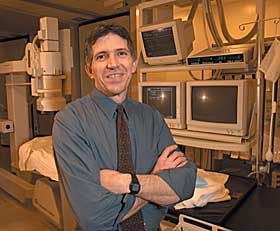|
This is an archived article.
For the latest news, go to the
Advance Homepage
For more archives, go to the Advance Archive/Search Page. | ||
|
Radiation Procedure Improves Use For patients with coronary artery disease, placing a stent or small steel mesh tube inside a narrowed artery to keep it open improves health, but one patient in five experiences restenosis, or a recurrence of the artery-clogging build-up that caused the disease in the first place. Cardiologists at the UConn Health Center are using a new technique to prevent that recurrence.
The procedure is called intravascular radiotherapy and it is a new application for radiotherapy, most commonly used to treat cancer. In the coronary procedure, a patient with restenosis again undergoes angioplasty, in which a thin tube or catheter with a tiny balloon at its tip is inserted into the narrowed artery. The balloon is inflated to push open the artery walls and widen the path for blood flow. After the artery is re-inflated, the doctor inserts a carefully controlled dose of radiation through the catheter to the stent site. After a prescribed amount of exposure, the radiation is withdrawn. The radiation impedes, and in some cases halts, the regrowth of tissue around the stent. "This is an exciting development in cardiology," says Dr. Michael Azrin, a cardiologist and assistant professor of medicine at the UConn School of Medicine. "The technology is proven; the procedure is minimally invasive and effective; and the outcomes are largely favorable. "This is an important addition to our armory for the treatment of coronary artery disease," he says. The equipment the doctor uses to administer the radiotherapy is manufactured by Guidant Corp. of Santa Clara, Calif. The device houses the isotope, automatically inserts it into the patient's catheter and sends it to the stent site, records the exposure, then withdraws it. A doctor who is a radiation oncologist monitors this portion of the procedure. "Radiotherapy has been used as a cancer treatment for years," says Robert Dowsett, a radiation oncologist who is a member of the team that performs the procedure. "The radiotherapy portion of the procedure is computer-controlled and guided. "The advantage of the technology is that you can treat a small amount of tissue precisely and not radiate other areas or organs significantly," he adds. The Health Center's team is the first in the state to use the advanced equipment produced by Guidant. |

